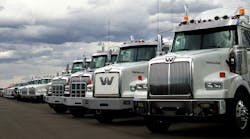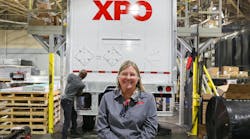After earning a Bachelor’s in mechanical engineering from Texas A&M, Mike Dozier embarked on a career with Paccar, the global truck maker.
Seventeen years later, after assignments in everything from product design to manufacturing engineering to operations auditing, Dozier was tapped earlier this year to be chief engineer of the firm’s Kirkland, WA-based division, Kenworth Truck Co.
Now that he’s truly in the catbird seat of vehicle development, he says the view ahead is clear but the engineering it will take to get there is complicated.
“At Kenworth, we strive to continually update our products,” says Dozier, “which keeps the pipeline full of the ‘next new thing.’
“But,” he continues, “there’s no mistaking that the engineering activity needed to meet the EPA ’07 and ’10 emissions regulations, including electronic developments, are a major influence right now.”
Dozier says integrating exhaust aftertreatment systems for ’07 engines is “technically challenging but not a basic design issue.”
He notes that although component suppliers will produce the elements of the aftertreatment system, integrating them onto the vehicle will be the responsibility of OEMs.
“What we’ll be dealing with,” Dozier elaborates, “is a high-temperature exhaust system that will have to be completely sealed—that is to say, the band clamps of today will not be the band clamps of tomorrow. In general, integrating the aftertreatment system into the exhaust will drive up the complexity of the vehicle.”
To deal with this challenge, Dozier says Kenworth is now “regarding the complete exhaust system as an engine component. The aftertreatment system is really part of the engine’s design although it will be packaged within the exhaust—and that means those components will require more space on the vehicle than now.”
Dozier says the actual configuration of an aftertreatment-equipped exhaust on a 2007 Class 8 truck may be too large to fit within the confines of today’s typical 5-in. diameter exhaust piping.
“It will be a packaging challenge,” he states, “but one we are prepared for.” Dozier explains that Kenworth “has been working on ’07 integration for some time in conjunction with engine suppliers. Our extensive field-testing plans include having customer evaluation vehicles available.”
“We sell a premium product and the high expectations of our customers and their drivers regarding quality , fit and finish and functionality are always expected,” he remarks.
Turning specifically to meeting the needs of commercial drivers, Dozier says their expectations about vehicle design are rising with everyone else’s. “Just look at pickup trucks,” he observes. “Consumers expect them to be more than workhorses; to be comfortable and convenient. It’s the same with heavy-duty trucks—drivers want to be comfortable where they work.”
In fact, Dozier states that “raising the bar on interior fit and finish and functionality” is a key feature of the improvements made to Kenworth trucks for the current 2006 model year.
Dozier says the new interiors feature such improvements as a 100-ft. reduction in wiring to ease servicing; a 20% in-cab noise reduction; a new speedo/tach cluster with larger gauges standard with chrome bezels; and standard interior lighting that is better than any prior combination of optional lighting.
“We regard the new interiors as evolutionary,” he says, “building on our goal of always improving quality.” More to the point, Dozier says the new interiors will set Kenworth apart with interior “looks” that boast a “high-quality appearance yet give away nothing in terms of performance and functionality.
“Under the hood or in the cab,” Dozier adds, “all the pieces have to work on a heavy truck. It comes down to paying attention to the details.”


